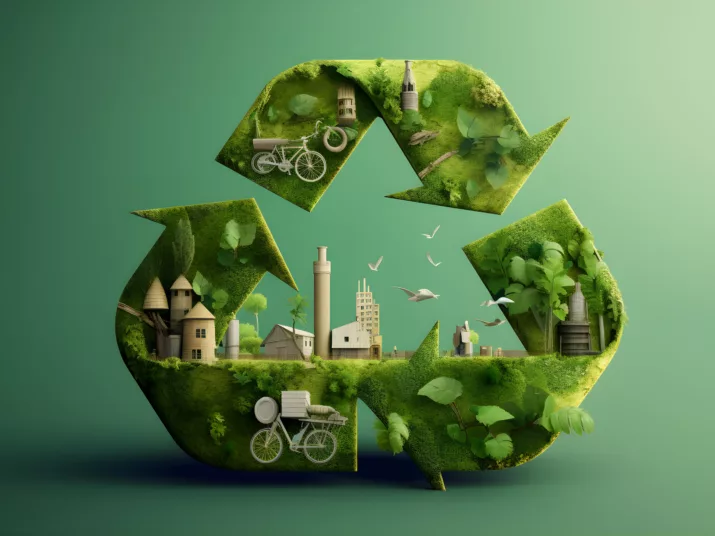
Nickson / Generated with AI via Adobe Stock
Thinking Space Nature
Design on Behalf of the Future
How does sustainable design have to look? What do we need to regard to stop generating more waste? How can products be given a second life? Circular design is the name of the solution that’s supposed to make the economy greener.

Nickson / Generated with AI via Adobe Stock
Whether it’s lithium for mobile phones or crude oil for plastic production, every day we consume large amounts of raw materials. Some of these are going to become scarce in the future, while the extraction of others will cause further mountains of waste or the pollution of water with harmful substances. The European Union (EU) alone produces 2.5 billion tonnes of waste per year. [1] The huge consumption of resources pollutes the climate and negatively affects the diversity of animal and plant species around the globe. [2]
One way out of this is offered to us by the so-called (new) circular economy. The EU defines it as follows: “The circular economy is a model of production and consumption, which involves sharing, leasing, reusing, repairing, refurbishing and recycling existing materials and products as long as possible. In this way, the life cycle of products is extended.” The scientist and expert on circular design Dr Sonja Eser suggests replacing the term “consumption” in this definition with the term “use of things”, because, in the ideal case, consumption should no longer take place at all. The EU definition goes on to say: “In practice, it implies reducing waste to a minimum. When a product reaches the end of its life, its materials are kept within the economy wherever possible. These can be productively used again and again (...).” [3] Another definition of the term “circular economy” can be found at the end of this text.
A comprehensive circular economy
Unlike in the 1980s, experts no longer understand the term “circular economy” to mean merely the recycling of product residues and the disposal of pollutants. The aim is to work on adjusting a wide set of parameters in order to use raw materials more efficiently and to reduce waste. Ideally, this means that a product is put back into the material cycle in its entirety following its use. According to the Club of Rome, the (new) circular economy could thereby bring about a reduction in greenhouse gas emissions of up to 70 per cent compared to the conventional economic model. [4]
Circular design principles are needed to make this possible. To this end, experts are discussing different methods. Here you can find some examples:
1.) Trust
Products offer an emotional quality: certain things are “loved” and trusted, and as a result will not be replaced so quickly – for example, a beautifully designed coffee machine that makes the “perfect” coffee. [5]
2.) Adaptability
The product can be adapted to changing needs. Upgrades are available, and individual components can be easily separated and reassembled. One example is an old bulldozer, which is dismantled down to its smallest components – and then turned into a new vehicle through recycling. Or a chair that “grows with the child”. [6][7]
3.) Long-Life
A product is kept in use for as long as possible – for instance, a washing machine with a lifetime guarantee. Designers make sure their designs are durable – little wear and tear, easy maintenance and servicing.[8][9]
4.) Support for the biosphere
Things should be designed in such a way that they “support or enrich biological life in our environment”, says designer Lars Zimmermann. Examples include posters that are biodegradable and contain seeds or provide nesting sites for insects. [10] Dr Sonja Eser adds: “Renewable resources should be cultivated sustainably. All biogenic material should be used in such a way that it can be returned to the biosphere at the end of its use, helping to rebuild soil and replace artificial fertilisers.”
5.) Replace or avoid
Various approaches are already in place to reduce or avoid the consumption of raw materials: window panes that never get dirty remove the need for cleaning agents; reusable systems allow for the reuse of products. [11]
6.) Regional material
More examples of circular design strategies and matching products are available here.
Circular economy
Experts often use the term circular economy in reference to the Ellen MacArthur Foundation, a British non-profit organisation: “The term ‘circular economy’ refers to a change in the entire economic system. A circular economy is an industrial system in which biological and technical materials are designed in such a way that they can circulate in cycles while retaining the highest possible quality. The biological nutrients used also serve the purpose of regenerating the natural capital ‘soil’. Technical nutrients are used in such a way that the products themselves, or parts of them, are kept in the economic system for as long as possible and circulate in the cycle, thereby restoring the greatest possible value. A circular economy relies on 100 per cent renewable energy and eliminates the use of toxic chemicals, as well as the creation of waste, through careful product design, other systems and business models. ” This definition of the term “circular economy” must not be confused with the one in the German Circular Economy Act (more information is available here). [12]
Sources and further literature
[2] https://www.kfw.de/stories/umwelt/natuerliche-ressourcen/kreislaufwirtschaft-grafik/
[4] https://clubofrome.org/publica..., p. 7
[7] http://circulardesigncases.nl/examples/category/circular-design-strategies/dis-reassembly/
[8] https://www.ellenmacarthurfoundation.org/explore/circular-design
[9] Circular Design in der Praxis: Strategien und Konzepte zur Gestaltung der neuen, regenerativen Kreislaufwirtschaft, Sonja Eser and Michael Leube (Ed.), 2017
[10] https://opencircularity.info/hbksaar-3/#1
[11] https://opencircularity.info/hbksaar-3/#1
[12] Sonja Eser